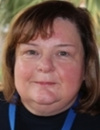
Thursday, 10 September 202000:00 | Biofilm Forming Multi-Resistant Pathogens on the ISS
Elisabeth Grohmann, Professor, Beuth University of Applied Sciences Berlin, Germany
The International Space Station (ISS) is a closed habitat in a uniquely extreme and hostile environment. Due to these special conditions, the human microflora can undergo unusual changes and may represent health risks for the crew. To address this problem, we investigated the antimicrobial activity of a novel surface coating consisting of micro-galvanic elements of silver and ruthenium along with examining the activity of a conventional silver coating. The antimicrobial materials and respective control materials were exposed on the ISS for different time-periods. On all materials, surviving bacteria were dominated by Gram-positives and among those by Staphylococcus, Bacillus and Enterococcus spp. The novel antimicrobial surface coating AGXX proved to be highly effective. Microbial diversity increased with increasing exposure time on all three materials. The number of recovered bacteria decreased significantly from the uncoated control material to the silver coating to AGXX. Most Gram-positive pathogenic isolates were multidrug resistant. Average resistance transfer frequency was 10-5 transconjugants/recipient. Importantly, no serious human pathogens such as MRSA or vancomycin-resistant Enterococci (VRE) were found on any surface. Thus, the infection risk for the crew is low, especially when antimicrobials such as AGXX are applied to surfaces prone to microbial contamination. | 00:00 | Title to be Confirmed.
Jack van Loon, Scientist-DESC (Dutch Experiment Support Center) and 3D InnovationLab, Vrije Universiteit Amsterdam, Netherlands
| 00:00 |  | Keynote Presentation Title to be Confirmed.
Danilo Tagle, Director, Office of Special Initiatives, National Center for Advancing Translational Sciences at the NIH (NCATS), United States of America
|
| 00:00 |  | Conference Chair Title to be Confirmed.
Jana Stoudemire, Director, In-Space Manufacturing, Axiom Space, United States of America
|
| 00:00 |  | Conference Chair Title to be Confirmed.
Marc Giulianotti, Program Director, International Space Station U.S. National Laboratory, United States of America
|
| 00:00 |  | Keynote Presentation Title to be Confirmed.
Christine Mummery, Professor and Chair of Developmental Biology, Leiden University Medical Centre, Netherlands
|
| 00:00 | How Nanotechnology Can Enable Research In Space
Veerle Reumers, R&D Manager, imec USA, Belgium
| 00:00 | Magnetic Levitational Biofabrication in Space Applying Different Objects
Elena Bulanova, Head of Cell Technologies, 3D Bioprinting Solutions Russia, Russian Federation
Magnetic levitational bioassembly of 3D constructs represents a novel rapidly emerging scaffold-free and label-free approach and alternative conceptual advance in biofabrication. The implementation of magnetic bioassembler in space is quite beneficial since the microgravity conditions facilitate magnetic levitation, which allows to use lower concentrations of toxic gadolinium salt to paramagnetise the culture medium. The magnetic bioassembler certified for space research is compact, automated and user friendly. We’ve developed a special cuvettes for successful samples delivery, experiment activation and performance, fixation and return to Earth.
Different 3D constructs have been biofabricated in space under Z-gravity conditions from tissue spheroids, bacteria and calcium phosphates applying different concentrations of paramagnetic in culture medium. Bioassembled 3D construct from different tissue spheroids demonstrated good viability, advanced stages of fusion process, appropriate tissue architecture and characteristics. Bacterial three-dimensional non-attached biofilms were produced from different E. coli strains as a suitable in vitro model for chronic infections. The magnetic levitation of calcium phosphate particles allowed the rapid creation of 3D scaffolds intended for bone defect replacement.
3D printing and 3D bioprinting in Space is beneficial:
- We will be able to travel much lighter printing the spare parts, creating working machine shop in Space
- Living spaces and laboratories will printed on the Moon and Mars
- The possibilities for bone and cartilage repair during long-term missions are quite desirable
- The bioprinting of food is beneficial
| 00:00 |  | Keynote Presentation Growing Tissues in Space
Daniela Grimm, Professor of Pharmacology and Space Medicine, Aarhus University, Denmark
Microgravity-based tissue engineering represents a new technology in
gravitational biology and translational regenerative medicine. The aim
of this presentation is to summarize recent findings observed when human
cells were exposed to real microgravity in space or to simulated
microgravity using ground-based facilities. |
| 00:00 | Title to be Confirmed.
Lucie Low, Tissue Chip Program Manager, National Center for Advancing Translational Sciences (NCATS), NIH, United States of America
| 00:00 |  | Keynote Presentation Bioprinting of Living Tissue Constructs For Space Exploration
Michael Gelinsky, Professor and Head, Center for Translational Bone, Joint and Soft Tissue Research, Faculty of Medicine, Technische Universität Dresden, Germany
For long-term space exploratory missions and extra-terrestrial human settlements, e. g. on Moon or Mars, the astronauts must be able to treat health problems on site as a fast return to Earth is impossible. 3D bioprinting is a promising technology which might allow fabrication of tissue constructs like skin and bone with limited equipment and materials which mostly could be produced locally. The presentation will give an overview about a study on bioprinting for space exploration which recently was carried out for the European Space Agency (ESA). We have investigated different bioprinting technologies, suitable biomaterials and also possible medical scenarios in which bioprinting might become an important tool. |
| 00:00 | Next-Generation Bioprinting for Manufacturing Tissue-Engineered Products
Fabien Guillemot, Chief Executive Officer, Poietis, France
Main challenges for the manufacturing of tissue engineered advanced therapy medicinal products (ATMPs) relate to the standardization of manufacturing processes and the improvement of tissue functionality, and cost-effectiveness and profitability of related treatments. Producing advanced therapy medicinal products remains a cumbersome process with costs, reproducibility and scalability issues. Poietis develops biomanufacturing solutions based on Next Generation Bioprinting (NGB). This new platform integrates automation and robotics technologies, and is coupled with numerous online sensors – including cell microscopy – and Artificial Intelligence processing. In addition, it integrates all bioprinting techniques (laser-assisted bioprinting, bioextrusion, micro-valve bioprinting), a world’s first in the bioprinting market. Based on our experience on bioprinting full-thickness skin equivalents, we will discuss how next-gen bioprinting technology – should make it possible to overcome current tissue manufacturing bottlenecks and also provide new therapeutic opportunities. | 00:00 | Controlling Vascular Organization in Engineered Tissues Using Patterns of Growth Factors
Jeroen Rouwkema, Associate Professor, University of Twente, Netherlands
Engineered tissues offer a great promise as an alternative for donor tissues, for which the supply is not meeting the demands. However, currently the clinical application of engineered tissues is hampered. The integration of engineered tissues after implantation is limited due to the lack of a vascular network. In order to achieve multiscale organized vascular networks within engineered tissues, we are developing methodologies to spatially control the organization of vascular cells within tissue analogues. A potent approach in this is to spatially control the availability of angiogenic growth factors. By combining an aptamer based growth factor scavenging approach with 3D printing technology to pattern the presence of the aptamers, the availability of the growth factor can be regulated both in space and time. With this approach, our aim is to locally control tissue remodeling and maturation, resulting in a vascular network that resembles a vascular tree. | 00:00 | Possibility of Application Examined From Clinical Research of Cell-based Therapy Using Microgravity
Louis Yuge, Professor & Main Director, Space Regenerative Medical Center, Hiroshima University, Japan
Microgravity is known to control cell cycle, cell proliferation, and differentiation. Gravity Controller “Gravite®” (Space Bio-Laboratories) is one of the 3D-clinostat. Gravite® is a multi-directional gravity device for simulating microgravity. By controlled rotation of two axes, a 3D-clinostat minimizes the cumulative gravity vector at the center of the device and makes 10-3G over time average. Our previous studies demonstrated simulated microgravity inhibited myoblasts and osteoblasts differentiation supporting data as gravitational space biology. Using Gravite®, we can culture underestimated stem cells, without drug treatment or gene manipulation. Our method of culturing stem cells therefore ensures safety and consistent quality at a reduced cost. We have demonstrated that using Gravite® results in a higher rate of stem cell proliferation than conventional methods. Regenerative medicine with MSCs has gained significant attention for the treatment of central nervous system diseases. We investigated the activity of human MSCs under simulated microgravity conditions. Neural-induced MSCs cultured under 1G conditions exhibited neural differentiation, whereas those cultured under microgravity did not. Moreover, under microgravity conditions, MSCs could be cultured in an undifferentiated state. Next, we intravenously injected cells into a model of cerebral contusion and spinal cord injury. Graft MSCs cultured under microgravity exhibited greater survival in the both neurological disorder models damaged region, and the motor function of the grafted animal models improved significantly. Currently, our TEAMS are conducting a clinical research project on cell therapy of cerebral infarction using cranial-derived mesenchymal stem cells (HUMAN Project: Hiroshima University MSC Applicative study for Neuro-regenerative therapy). |
Friday, 11 September 202000:00 |  | Keynote Presentation What Can Biofabrication Do For Space and What Can Space Do For Biofabrication?
Lorenzo Moroni, Professor, Biofabrication for Regenerative Medicine, Maastricht University and Founder MERLN Institute for Technology-Inspired Regenerative Medicine, Netherlands
Bioprinting in space is one of the novel promising and perspective research directions in the rapidly emerging field of biofabrication. There are several advantages of bioprinting in space. First, under the conditions of microgravity (µg), it is possible to bioprint constructs employing more fluidic channels and, thus, more biocompatible bio-inks. Second, µg-conditions enable 3D bioprinting of tissue and organ constructs of more complex geometries with voids, cavities, and tunnels. Third, a novel scaffold-free, label-free, and nozzle-free magnetic levitational bioassembly technology can be implemented under the condition of µg. The ideal space bioprinters must be safe, automated, compact, and user friendly. Thus, there are no doubts that systematical exploration of 3D bioprinting in space will advance biofabrication and bioprinting technology per se. Vice versa 3D bioprinted tissues could be used to study pathophysiological biological phenomena in µg and cosmic radiation that will be useful on Earth to understand ageing conditioning of tissues, and in space for the crew of deep space manned missions. Such novel 3D bioprinting technology can eventually be made accessible on ISS for both academic and industrial vast research user community. |
|
|

 Add to Calendar ▼2020-09-10 00:00:002020-09-11 00:00:00Europe/LondonThe Space Summit Europe 2020The Space Summit Europe 2020 in Rotterdam, The NetherlandsRotterdam, The NetherlandsSELECTBIOenquiries@selectbiosciences.com
Add to Calendar ▼2020-09-10 00:00:002020-09-11 00:00:00Europe/LondonThe Space Summit Europe 2020The Space Summit Europe 2020 in Rotterdam, The NetherlandsRotterdam, The NetherlandsSELECTBIOenquiries@selectbiosciences.com